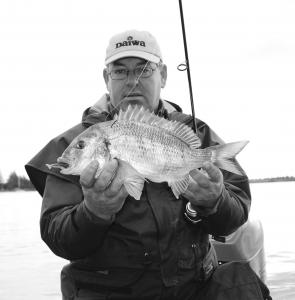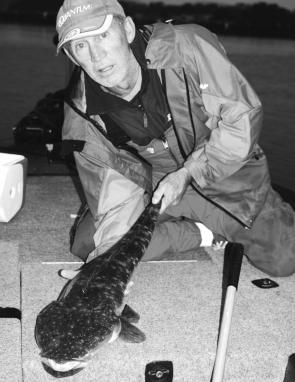I’ve written about the effects of rain on the coastal fringe before and while the momentary disruption is annoying, the overall benefits are fantastic. The rise in water levels help to flush the system of dead water and triggers fish to move in and out of our estuaries.
It gives the jew spinners and bait fishos an opportunity and increased hope and helps to pull the bream into the lakes and rivers, away from their Winter coastal rock holiday. Spawned blackfish filter into the weeded areas of the estuary and dodge the current behind oyster lease posts.
The blackfish in the lower end of the lake and the weed humps near the eastern side of Wallis Island have been keeping the keen anglers happy. The average 300g to 450g fish are occasionally beaten to the bait by big models up to 900g, which I’m sure delight the anglers.
A few blackfish anglers have been persisting around the Tuncurry side of the bridge and the rock wall east of the Co-op wharf but the fish are well spread through the system and often fall to soft plastics.
By now the bream should have started pushing back into the lake to areas like Black Rock and the weed flats at the back of Coomba Park and Pipers Bay. The fish were pretty concentrated down around The Paddocks for a long while after the fresh in August with big bags of 35cm-plus fish being taken over the flats and racks.
Shallow Jackall Chubbies and Ecogear SX 40 lures were the main choice of anglers while others preferred to jig the eddies and washboards at the end of the run-in tide and the first part of the run out with 2” Gulp shrimp in lime tiger and natural colours.
As always, the fresh had a limited kill of cunje on the bridge pylons and the bream were thick at the change of the tide. There is always a good number of bream on the bridge and why not – there is plenty of food hanging from the concrete.
It is important that you pick the tide change if you intend to fish the bridge because the water runs hard under it and the bream, flathead and whiting get in tight to the pylons. Unless you anchor your boat and use bait it is difficult to fish effectively with the tide howling through.
There are always a few big flathead kicking around the bottom end of the lake during Winter but by the end of the month there should be an increase in numbers as they gather to spawn.
I must stress that it is a good idea to release the big females but handling is very important, as we found a decaying 6kg fish floating belly-up not long ago. It may have been a fish that escaped the sharp point of a spearfisher or the result of a gut hook. The point is we may see the fish swim away from the boat but it may die later so use best practice when handling all our big breeders.
Ross Lamotte caught his biggest flathead the other week on 6lb leader and a Gulp shrimp meant for bream. An Environet landing, photo, dehooking and release as fast as we could manage meant the fish, well over the magic 10lb mark, swam away strongly.
One of the seasonal attractions to the lower end of the lake for the flathead and the locals is the run of trumpeter whiting that school up around Little Tern island and the Wallamba proper along Cockatoo Island. If you are not familiar with the whiting run, just look for the six to 12 boats anchored in the channels with fishos all winding in the small whiting. Live or preserved worms and yabbies are good bait.
Offshore, the leatherjackets should be thinning out with more pearl perch and snapper coming in to the cleaning tables.
Many anglers have taken to throwing soft plastics for snapper over the shallow coastal reefs. Just off Blackhead and around Latitude Rock are good spots.
There are plenty of flathead and the odd silver trevally around but have a few spots in mind because the fish are in patchy schools.
Offshore or even close inshore, you can still catch tailor and salmon but, as a few local anglers found out, there are drawbacks to the vast salmon schools. One is you don’t go swimming with them. Four anglers along Seven Mile beach were fishing for whaler sharks when they managed to land and release unharmed an estimated 2.5m white pointer. This white was one of seven or eight sighted along the beach and at least one surfer had a shark nudge his board twice.
Bream, dart and tailor make up the beach fisho’s bag while the salmon are great fighters and make great ... sport? Seriously, salmon are a fantastic sport fish and do make fish cakes that are passable.
Gutter formations will be the key to the beach success and the way the weather and seas change, it will be a matter of having a look the day before you intend to fish. Blueys Beach has had some features and if you want to escape the strength of the south-easterly or south-westerly winds, Elizabeth Beach is worth a look.
With the freshes in the rivers we have had this year, I don’t think I’d be risking much to suggest that the bass season is going to be a beauty. I think I’ll be hitting all the backwater spots early this year just to take advantage of the early fish movements back upstream.
Reads: 1476
Seamo with a 1.2kg bream from under the bridge on a Gulp Shrimp. Fishing the lure slowly and close to the pylons at slack water is the go.

Ross Lamotte with his best flathead just prior to release. Be careful with these big breeders.

A good bass season is expected this year after regular rainfall. This big fish took a Jackall frog just on dark.




